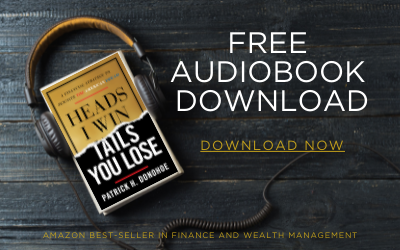At Paradigm Life, we believe in systematic thinking, radical transparency, and risk management—the same principles advocated by Ray Dalio in his groundbreaking book, “Principles”. As the founder of Bridgewater Associates, the world’s largest hedge fund, Dalio has revolutionized the way investors approach diversification and risk management. These principles have guided investors towards more disciplined decision-making and financial success, and they can be just as powerful in your personal wealth-building strategy.
In this post, we’ll explore how Ray Dalio’s principles can be applied to diversify your portfolio and manage risk, just as Dalio does with his investments. But here’s the twist: we’re also going to show you how life insurance—a cornerstone of The Perpetual Wealth Strategy™—can play a critical role in applying Dalio’s principles to your own financial freedom.
Understanding The Principles of Ray Dalio : A Blueprint for Investment Success
Ray Dalio’s “Principles” is more than just an investment guide—it’s a comprehensive framework for achieving success in all areas of life. The book is divided into two parts: life principles and work principles, with each section providing actionable insights into decision-making, leadership, and problem-solving. While Dalio’s principles apply to various aspects of life, they’re especially powerful when applied to investing.
Key principles from Dalio’s book that have helped countless investors build wealth include:
- Radical transparency: Encourage open, honest communication for better decision-making and risk management.
- Systematic thinking: Approach decisions with a structured, logical framework that helps you stay objective and consistent in your investment strategy.
- Risk management: Focus on identifying, assessing, and managing risks to protect and grow your portfolio.
Understanding Correlation and Diversification: Building a Stable, Resilient Portfolio for Your Financial Future
When it comes to investing, one of the most critical strategies for building a stable and resilient portfolio is understanding correlation and how it works in conjunction with diversification. Both concepts play a central role in reducing risk, protecting wealth, and ensuring long-term growth. At Paradigm Life®, we believe that a well-diversified portfolio is essential for achieving financial freedom and lasting prosperity—and it all starts with understanding the relationship between assets.
What is Correlation?
Correlation refers to the relationship between two or more assets in your portfolio and how they move in relation to each other. In simpler terms, it shows whether the price of one asset increases or decreases when another asset’s price changes. Correlation is measured on a scale from -1 to +1:
- A positive correlation (closer to +1) means the assets move in the same direction—when one goes up, the other tends to go up, and vice versa.
- A negative correlation (closer to -1) means the assets move in opposite directions—when one asset increases in value, the other tends to decrease.
- A zero correlation means that there is no relationship between the movements of the assets.
Understanding the correlation between different assets in your portfolio is essential for managing risk. The more uncorrelated your investments are, the less likely it is that they will all experience losses at the same time. This reduces the overall risk to your portfolio and provides stability, especially during periods of market volatility.
The Power of Diversification: Reducing Risk and Building Stability
Diversification is one of the best ways to reduce risk and improve your portfolio’s performance. In simple terms, it means spreading your investments across different assets so that no single one dominates your portfolio’s risk.
Ray Dalio, known for his systematic investment approach, stresses the importance of holding 15 uncorrelated assets. By investing in assets that don’t move in the same direction, you can lower overall risk. If one investment loses value, others may stay stable or even grow, creating a more resilient portfolio.
At Paradigm Life, we apply Dalio’s principles through The Perpetual Wealth Strategy™. We combined life insurance with diversified investments to build long-term financial security, liquidity, and tax-efficient growth.
Why Correlation Matters for Diversification
The main goal of diversification is to spread risk so your portfolio isn’t tied to just one asset. By choosing assets with low or negative correlation, you protect against market changes.
For example, if you hold both stocks and bonds, stocks may be volatile, but bonds usually act differently. When stocks drop, bonds might stay steady or rise, balancing out your portfolio’s performance. This negative correlation reduces the risk of large losses, making your portfolio more stable and resilient.
In short, diversification ensures that not all your financial eggs are in one basket. When assets perform differently, it lessens the chance of big losses, giving you a smoother and more predictable path to financial growth.
How Diversification Works in Practice
To implement Dalio’s diversification principles, here are the key steps to follow:
- Identify uncorrelated assets: Start by analyzing the correlation between the assets in your portfolio. Aim to select assets with low or negative correlation, as these provide the best protection against market fluctuations.
- Diversify across asset classes: Diversification isn’t just about choosing different stocks. It’s about spreading your investments across various asset classes—stocks, bonds, real estate, life insurance policies, and more. Each asset class behaves differently in different market conditions, helping to reduce risk.
- Aim for consistency: Build a portfolio that includes at least 15 uncorrelated assets, as Dalio suggests, to ensure that your investments are spread out across different sectors and market conditions. The more uncorrelated assets you hold, the better your portfolio will handle unexpected downturns.
- Monitor and rebalance: Diversification is not a one-time strategy. As market conditions change, correlations between assets may shift. That’s why it’s important to regularly rebalance your portfolio, ensuring that it remains diversified and aligned with your long-term financial goals.
Steps to Determine Asset Correlation and Build a Diversified, Resilient Portfolio for Your Financial Future
One of the most important strategies to achieve long-term financial freedom and wealth is understanding asset correlation and effectively diversifying your portfolio.
By applying Ray Dalio’s principles to your investment strategy, you can reduce risk, safeguard your wealth, and optimize your returns. Let’s dive into how you can determine asset correlation and create a diversified portfolio tailored to your financial goals.
Step 1: Data Collection – Building the Foundation for Your Portfolio
Before you can analyze asset correlation, you need solid, historical data. This is your foundation. Begin by gathering historical price data for each asset in your portfolio. Reliable sources for this data include:
- Yahoo Finance
- Google Finance
- Your brokerage account’s historical data tools
Collecting accurate data is crucial for effective analysis. The more precise your data, the more reliable your correlation calculations will be, helping you make better decisions for your portfolio.
Step 2: Calculating Correlations – Understanding How Assets Interact
Once you’ve collected the data, it’s time to calculate asset correlation. You can use tools like Excel or Google Sheets to make this easy. For example, in Excel, the CORREL() function will calculate the correlation coefficient between two assets, showing how their price movements are related.
Here’s how it works:
- A positive correlation means the assets move together. When one goes up, the other tends to rise too.
- A negative correlation means the assets move in opposite directions. When one rises, the other tends to fall.
- Zero correlation means there’s no relationship between the movements of the assets.
Understanding these relationships allows you to build a portfolio that balances risk, ensuring that poor performance in one asset is offset by stability or gains in another.
Step 3: Analyzing Correlations – Finding the Right Mix of Assets
After calculating the correlations, it’s time to analyze the results. A correlation matrix is a great tool to visualize how each asset in your portfolio interacts with others. Look for low or negative correlations—these are the assets that don’t move in sync, which is exactly what you want for diversification.
Dalio’s approach emphasizes the power of uncorrelated assets. By holding investments that don’t move in the same direction, you can reduce overall risk and improve the stability of your portfolio.
Step 4: Constructing a Diversified Portfolio – Spreading Risk to Maximize Returns
Now that you have your correlation analysis, it’s time to apply it and start building your diversified portfolio. Choose assets that have low or negative correlations with each other. Dalio suggests holding at least 15 uncorrelated assets to maximize diversification and minimize risk. The more uncorrelated assets you have, the more resilient your portfolio will be.
The goal of diversification is to spread risk. If one asset suffers losses, others will likely remain stable or even perform well. This reduces the chance of big losses and helps keep your portfolio’s performance more consistent.
Step 5: Monitoring and Rebalancing – Keeping Your Portfolio on Track
Diversification is not a “set it and forget it” strategy. It’s essential to monitor and rebalance your portfolio regularly to ensure it stays aligned with your goals. Over time, asset correlations can change as market conditions shift. Rebalancing ensures that your portfolio remains diversified and continues to reduce risk as much as possible.
Rebalancing also allows you to make adjustments based on changes in your financial situation or goals. It’s important to periodically review your portfolio, ensuring that you maintain the right mix of low or negative correlation assets and adapt to any changes in the market.
Applying Dalio’s Principles for Personal Financial Growth and Risk Management
Ray Dalio’s principles, including radical transparency, systematic thinking, and risk management, have shaped Bridgewater Associates into the world’s largest hedge fund. By adopting these strategies, you can build a more stable, resilient financial future and protect your wealth from unpredictable market shifts.
Let’s break down how Dalio’s core principles can guide you toward financial freedom and the peace of mind that comes with a strong, diversified portfolio.
Radical Transparency and Idea Meritocracy
Radical transparency encourages open, honest communication, which is essential for making informed financial decisions. At Paradigm Life, we value transparency with our clients, helping them understand the benefits of using life insurance as a strategic tool for tax-deferred growth and liquidity. Just as Dalio advocates for transparent decision-making, we believe in empowering you to understand every step of your wealth-building journey.
Systematic Thinking in Investment and Wealth-Building
Dalio’s systematic thinking emphasizes the importance of having a structured approach to making decisions. Whether you’re choosing life insurance options or diversifying your investments, a systematic framework ensures that each choice aligns with your financial goals. Tools like SWOT analysis and investment algorithms help you stay consistent and objective.
Risk Management – Building a Financial Buffer for Long-Term Security
Effective risk management is about protecting your portfolio from unforeseen setbacks. One of the key strategies in managing risk is having a financial buffer, which can be crucial during unexpected market downturns or personal financial emergencies. Life insurance serves as an ideal financial buffer, providing liquidity and a safety net when you need it most.
Additionally, having the right insurance coverage—such as life, health, and property insurance—helps protect you from significant financial losses. These protections allow you to safeguard your wealth and ensure you’re not left vulnerable during challenging times.
Dalio’s principles of risk management can be easily applied to your personal wealth strategy. By incorporating life insurance into your plan, you can mitigate risk while also building long-term, tax-efficient growth.
Tools and Resources for Correlation Analysis: Building a Resilient, Diversified Portfolio
Understanding and applying the right tools for correlation analysis is key to building a diversified, resilient portfolio that can help you achieve financial freedom. By analyzing how different assets interact, you can reduce risk and optimize returns, which are central to our approach in wealth-building. Here are some valuable tools and resources to help you get started with correlation analysis and move closer to your financial independence.
Step 1: Excel/Google Sheets – Accessible Tools for Beginners
For those just starting out, Excel and Google Sheets are powerful, accessible tools for basic correlation calculations. Both platforms come with built-in functions like CORREL() to quickly calculate the correlation coefficient between two assets, helping you understand how they move in relation to each other.
These tools also offer charting and data visualization options, making it easier to interpret your findings and present your analysis. Whether you’re building your first portfolio or managing an existing one, these tools provide a simple yet effective way to start applying diversification principles and reduce risk.
Step 2: Financial Software – Advanced Tools for Professional Analysis
For more advanced analysis, financial software tools such as Bloomberg, Morningstar, and Portfolio Visualizer are invaluable. These tools provide professional-grade data and analytics that can deepen your understanding of asset relationships and portfolio performance.
- Bloomberg: Offers comprehensive data and advanced analytics tools, ideal for professional investors.
- Morningstar: Specializes in mutual funds, stocks, and investment reports, offering in-depth analysis for building a diversified portfolio.
- Portfolio visualizer: Focuses on portfolio optimization, including sophisticated correlation analysis and risk management tools to improve portfolio performance.
These resources are perfect for those who want to take a deeper dive into asset correlation, diversification, and portfolio optimization to enhance their wealth-building strategies.
Step 3: Python – Advanced Customization for Expert Investors
For those who are comfortable with programming, Python is a fantastic tool for advanced correlation analysis. Using libraries like pandas and numpy, you can handle large datasets, perform complex calculations, and automate data collection. Python’s matplotlib and seaborn libraries even allow you to visualize correlations in more detailed and customized ways.
While Python requires a bit more technical expertise, it offers flexibility and precision that is invaluable for investors who want to take full control of their data analysis and tailor their investment strategies accordingly.
Practical Example
Creating a Sample Correlation Matrix
To illustrate how to determine asset correlation, let’s create a sample correlation matrix step-by-step:
- Collect data: Gather historical price data for five assets (e.g., Stocks A, B, C, D, and E) over the past year.
- Input data: Enter the data into Excel or Google Sheets, with each column representing a different asset and rows representing daily prices.
- Calculate correlations: Use the CORREL() function to calculate the correlation between each pair of assets. For example, =CORREL(A2:A253, B2:B253) will give the correlation between Stock A and Stock B.
- Create matrix: Fill out the correlation matrix with the calculated correlation coefficients.
Here’s a visual representation of the correlation matrix:
| Stock A | Stock B | Stock C | Stock D | Stock E | |
| A | 1.00 | 0.30 | -0.20 | 0.10 | -0.40 |
| B | 0.30 | 1.00 | 0.50 | -0.10 | 0.20 |
| C | -0.20 | 0.50 | 1.00 | 0.30 | -0.30 |
| D | 0.10 | -0.10 | 0.30 | 1.00 | 0.00 |
| E | -0.40 | 0.20 | -0.30 | 0.00 | 1.00 |
Portfolio Construction
Using the correlation matrix, we can select 15 uncorrelated assets to construct a diversified portfolio. Let’s assume the above matrix is part of a larger dataset. The selection criteria should focus on assets with low or negative correlations.
- Select assets: Choose 15 assets with the lowest correlations to each other. For instance, if Stock A and Stock E have a correlation of -0.40, they are good candidates for inclusion in the portfolio.
- Diversify sectors and classes: Ensure the selected assets come from different sectors and asset classes to maximize diversification.
- Allocate proportionally: Distribute investments across these 15 assets in a balanced manner to avoid over-concentration in any single asset.
Here’s a visual representation of the diversified portfolio:
| Asset | Allocation (%) |
| Stock A | 6.67 |
| Stock B | 6.67 |
| Stock C | 6.67 |
| Stock D | 6.67 |
| Stock E | 6.67 |
| Stock F | 6.67 |
| Stock G | 6.67 |
| Stock H | 6.67 |
| Stock I | 6.67 |
| Stock J | 6.67 |
| Stock K | 6.67 |
| Stock L | 6.67 |
| Stock M | 6.67 |
| Stock N | 6.67 |
| Stock O | 6.67 |
By following these steps, you can build a diversified portfolio that adheres to Ray Dalio’s principles, ensuring a balanced and risk-managed investment strategy.
Building a diversified portfolio not only aims for financial success but also strives for meaningful work and meaningful relationships. This approach aligns with Dalio’s principles, emphasizing the importance of fulfilling and purposeful work, as well as strong, effective relationships within an organization.
Start Building a Diversified, Resilient Portfolio Today
By following these steps to determine asset correlation and build a diversified portfolio, you’ll be on your way to achieving long-term financial stability and wealth. At Paradigm Life, we integrate Ray Dalio’s principles into our approach to The Perpetual Wealth Strategy™, which combines life insurance with diversified investments to optimize growth, liquidity, and financial protection.
Take the next step toward building your own resilient, diversified portfolio. Schedule a consultation with a Paradigm Life Wealth Strategist today to explore how The Perpetual Wealth Strategy™ can help you achieve financial freedom and a secure future.







